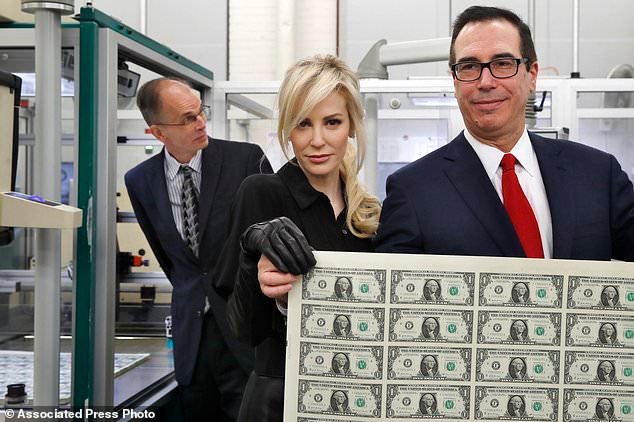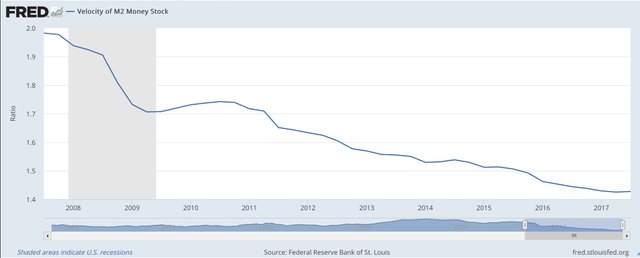Information Economy 2.0
Bitcoin is a Trillion $ Economy
We often hear that we live in an Information Economy. We have an information-based economy, but we don’t have a pure form of “money as information”. Instead we have a hybrid of digital money and paper money with encoded information such as denomination and serial numbers and engraving details.
Money (Money 2.0, ‘paper’ fiat money) today is mostly information, but the modern monetary system was designed long before the Information Economy. Even so, money is mostly held in digital form, on the ledgers of banks, and as monetary reserves at central banks. Physical currency in circulation is a small fraction of the money supply. So today it is a hybrid. One can argue it is not fully suited to our rapidly evolving information economy.

Steven Mnuchin, Treasury Secretary, and Wife Posing as Bond Villains, while Enjoying Dollar Bills at the Bureau of Engraving
Bitcoin and cryptocurrencies collectively are Money 3.0, a form of money that is entirely digital, entirely information. Even if you have a physical bitcoin wallet or paper wallet, the money does not reside in the wallet, only the keys! The keys release bitcoin money held on the blockchain.
Trying to separate the blockchain from bitcoin or cryptocurrency is like trying to separate the economy from information in the information economy. The blockchain holds the ledger information, the cryptocurrency powers the economy. The term ‘blockchain’ does not appear even once in Satoshi Nakamoto’s seminal paper for bitcoin and cryptocurrency. See this OrionX.net podcast discussing Nakamoto’s vision and the Nakamoto consensus algorithm:
Today, market participants mostly look at the market cap of bitcoin and other cryptocurrencies, as if they were some sort of equity shares. But actually, they are currencies, or perhaps digital gold, and what is somewhat strangely called ‘market cap’ is actually the money supply for that currency. It is simply the price of bitcoin, times the aggregate number of bitcoins in circulation. Here, in circulation means securely committed to the blockchain through a cryptographic hashing algorithm.
The size of the economy for bitcoin is related not only to the money supply, but also how rapidly that turns over. In macroeconomics this is called monetary velocity. In fact GDP = M2*V where the GDP is equal to the M2 money supply and V is the velocity of that money. It reflects how fast money moves through the system per year.
In the US the GDP is about $19.5 Trillion, the M2 money supply is about $13.7 Trillion and the velocity is about V = 1.42. That is, on average, the money supply turns over 1.42 times per year. In fact the Federal Reserve has been worried that the velocity is too low. It has been dropping steadily, which is a symptom of stagnation.

Velocity of M2 Money: Federal Reserve of St. Louis
For bitcoin the velocity is much higher. It turns over about 20 times a year, V = 20. Today the money supply or market cap for bitcoin is about $158 billion. With a velocity of 20, that translates to a bitcoin economy that is over $3 trillion. That amounts to around 16% of US GDP (roughly equal to annual health care expenditures) and more than the GDP of The Netherlands. Bitcoin is not usually described in such terms, but this is a measure of the vibrancy of the economy for the cryptocurrency.
Many cryptocurrencies have even higher velocities. Bitcoin Cash, which has only been in existence a few months, has a velocity of 28 and a total economy of over $700 billion, similar to the GDP of Switzerland. The world economy of cryptocurrencies exceeds about $9 trillion. This is about twice the GDP of Japan.
While cryptoeconomies are much less developed and have high levels of speculation, the overall size is indicative of the great potential they provide utilizing “Money in the Internet”.
Bitcoin and other cryptocurrencies are enabling the Information Economy 2.0, in which whole new forms of efficient exchange of value can be implemented with fewer or even no middlemen and at lower cost.
Congratulations @surfdog888! You have completed some achievement on Steemit and have been rewarded with new badge(s) :
Click on any badge to view your own Board of Honor on SteemitBoard.
For more information about SteemitBoard, click here
If you no longer want to receive notifications, reply to this comment with the word
STOP